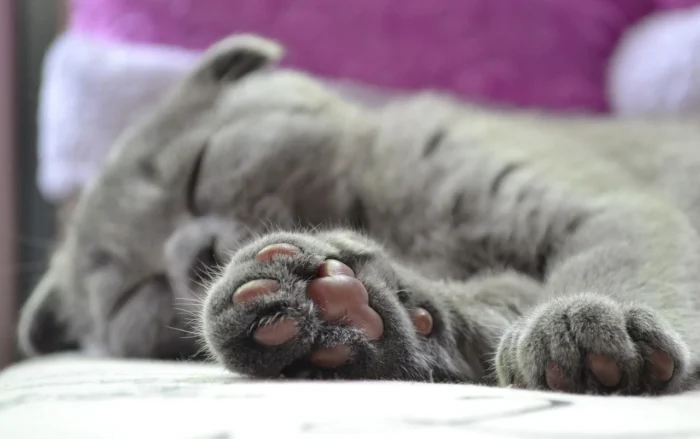Cats' paws are really special! But do you know what you need to know? They're not just for walking and running. They have a lot of great stuff, like soft pads and incredible flexibility. A closer look reveals lots of interesting things about these paws that make our feline friends even cooler!
In addition to having dedicated places where they can do their claws, cats need a good, healthy diet with plenty of fresh meat in order to stay as healthy as a lion!



Cat paws: facts you need to know

1 - Unique fingerprint
Each cat has its own fingerprint, which is like an identity card for them. These impressions are formed by unique lines and patterns on the pads of the front and hind legs. Even between siblings, no two prints are the same. That's what makes each cat truly special and unique!2 - The color of the pads varies according to the coat.
The paw pads of our feline friends can have different colors. For example, cats with light coats often have pink or light-colored paw pads, while those with dark coats often have darker, sometimes even black, paw pads! It's like a little touch of color to match their fur coat. It's another charming way to see the diversity of cats and their unique beauty.3 - Cats have different numbers of toes per leg
Cats' paws are one of nature's mysteries. They have 5 pads on their front legs, but only 4 on their hind legs. What's more, cats are very quiet when they walk. This is because they move on the tips of their paws, using only their pads most of the time.4 - Sensitivity
Cats' paws are very vulnerable to injury. Their pads are soft and supple, but they can be easily injured by rough, sharp or hot surfaces. Cats are very aware of their own fragility and often take special care of their paws.5 - Retractable claws
Cats' retractable claws are like secret weapons, hidden in their paws until they're needed. These sharp claws are retracted into special sheaths under the skin, enabling cats to walk, jump and climb with ease without damaging their precious claws. When hunting or feeling threatened, cats can deploy their claws in an instant, ready to defend or attack. What's more, we can check the condition or trim a cat's claws by pressing on the pad. This will cause the claw to come out automatically.
6 - Environmental information
Cats' paws are incredibly sensitive, almost like antennae exploring their environment. Thanks to thousands of sensory receptors in their paw pads, cats can detect the slightest variations in texture, temperature and even pressure under their paws. This allows them to hunt or hide in total discretion.7 - Protectors
The pads on a cat's paws are not only soft and cute, they also play a crucial role in protecting these agile felines. These thick, flexible pads act as natural shock absorbers, absorbing shocks and protecting bones and joints when they jump or land. What's more, the pads offer incredible grip, enabling cats to move with agility on a wide variety of surfaces, whether smooth, rough or even vertical.8 - Regulates body temperature
Unlike us, cats have a different way of regulating their body temperature: their paw pads! Cats' paw pads contain sweat glands that enable them to perspire. So its legs play an important role in its thermal regulation!9 - Brand the area & communicate
Cats' paws have a little secret: they can secrete a unique scent. These glands, located between the pads of their paws, release a distinctive scent when cats mark their territory by scratching or rubbing against surfaces. It's like an olfactory map for other cats, showing who was there and when. This allows cats to mark their territory and also to communicate. So they can sense in the secretion that another cat has been under stress, is ill or angry.10 - Kneads when he's happy
You may have noticed that your cat sometimes kneads with his paws, as if he were kneading bread dough. This behavior, known as "kneading", is a common habit among many cats. They often knead gently with their front paws, alternating between the two, often purring. This behavior dates back to their infancy, when they suckled their mothers for milk. Even in adulthood, kneading can be a sign of comfort, contentment or even happiness.








